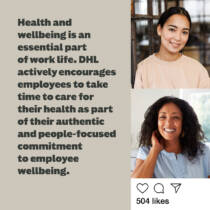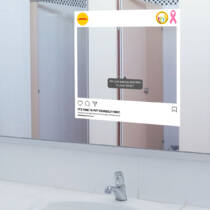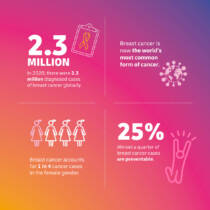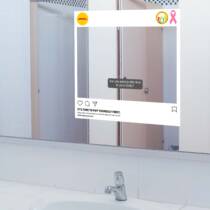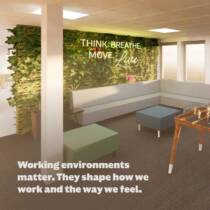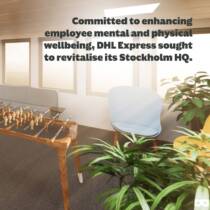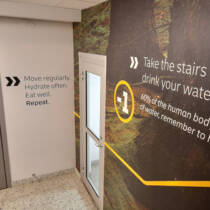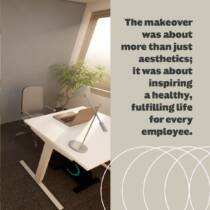Raising the profile of HR: strategies for shaping perception and impact
By Sally Pritchett
CEO
HR has never been more essential. But how can you elevate the profile of HR to drive transformative change, foster a thriving organisational culture and begin to change the professional stereotype?
With global uncertainty – conflicts, climate change, and economic struggles – employees are navigating tough times. They’re also increasingly seeking a stronger sense of belonging and purpose in their work. On top of this, challenges such as multi-generational workforces, a healthcare system under extreme pressure, and a growing burnout and mental health crisis are compounding the difficulties for HR. And ever present are the rapid technological changes and heightened concerns about AI and automation. These all combine to make HR’s role more vital – and complex – than ever.
Never more has HR needed to be positioned as a strategic partner, contributing valuable insights to decision-making.
Examining the reputation of HR
On the 19th April, we were delighted to host a virtual discussion for HR leaders focusing on raising the HR profile both externally and internally. Our CEO and Co-Founder, Sally Pritchett was joined by expert in HR PR, Kay Phelps, and together they discussed the impact of the negative media narrative on HR.
Kay shared a range of recent headlines from ‘What’s the point of HR?’ (FT Podcast) and ‘How the HR monster destroyed the workplace’ (Telegraph) to the rather depressing ‘Why everyone (still) hates HR’ (TLNT) and ‘HR viewed as least productive department by employees’. (HR Magazine).
Kay and Sally reflected on the adage ‘sticks and stones can break my bones but words can never hurt me’ suggesting that in this case, it appears that words are hurting the professional reputation of the HR function with 83% of HR professionals believing that HR is suffering from a tarnished reputation (Cezanne/HR Ninja research) and 54% of HR professionals feeling they rarely or never receive recognition for their efforts.
But there’s evidence that the damage is far worse than purely this tarnished reputation within organisations with poor and ever-diminishing investment in HR clearly out of balance with other functions.
Average HR function spend (as a percentage of revenue) stands at just 0.76% in comparison to other better-funded functions like Finance achieving 1.30%, IT at 3.25% and even marketing (a previously also function challenged by its reputation as a colouring in the department) now achieving a whopping 7.5%. (Gartner research)
Worst still, this underfunding is potentially set to worsen as 25% of 2023 HR budgets decreased year on year, (adding to a decrease of 12% in the previous year). (Fortune)
Strategies for shaping perception and impact
HR’s role in the business is expanding rapidly, encompassing critical areas such as workplace culture, diversity, equity, and inclusion (DEI), employee well-being, and talent acquisition. This includes fostering a sense of inclusion, belonging, and psychological safety, as well as aligning the workforce with the organization’s purpose and creating fulfilling roles. HR is also tasked with navigating the complexities of hybrid working arrangements, engaging a diverse workforce, and ensuring a seamless employee experience from start to finish. Furthermore, HR plays a pivotal role in talent retention amidst a competitive landscape, bridging generational gaps, supporting executive development, and preparing for the AI-enabled future of work. Amidst organizational transformations, HR juggles these responsibilities alongside redundancy programs, restructures, and job redesigns. The scope of HR’s remit is ever-expanding.
With HR being the least funded function and investment headed in the wrong direction whilst the remit and complexity of strategic HR’s role growing, Sally and Kay were keen to create a circuit breaker, seeking practical and tangible ways to help HR leaders move forward.
Sally reflected on a similar challenge a decade ago in her career, supporting a shift in the reputation of a marketing function including successfully increasing team size, budget and strategic profile within the business after three years of educating the wider business, shifting narrative from output (delivery) to impact (the difference made).
Kay and Sally shared their advice on building personal profiles, leveraging external media, engaging in the HR award landscape, educating their internal stakeholders and demonstrating their strategic contribution.
To find out more about their advice, watch the video below, or book a call to talk about your challenges with Sally here.
Championing workplace health, wellbeing and safety
By Sally Pritchett
CEO
In this article we share insights for internal communications leaders on a quest to move the dial on health, wellbeing and safety conversations.
The conversation on health and safety at work has been shifting for some time now. The emphasis used to be on safety, prioritising physical injury prevention, such as addressing slips, trips, falls, proper lifting techniques, and the importance of PPE, or adherence to safety protocols for tasks at heights. However, there has been a notable shift towards a more comprehensive perspective, encompassing not only physical safety but also considerations of health and wellbeing.
At Something Big our mission is to make a meaningful difference to workplaces, making them fairer, healthier and happier for all. In this article, we’re unraveling a little more on what we might mean by a ‘healthier’ workplace.
What is a healthy workplace?
We often refer to an organisation only being as healthy as its people, so it’s great to unravel what that might look like in the context of a world where according to the World Economic Forum we’re living longer but not necessarily healthier. Interestingly wealth has often also been seen as a measure of health, the thought that those with money could therefore afford better food, lifestyles and would automatically thus be healthier. We now know that wellbeing is not this linear.
If we narrow health down to the workplace we can see some clear buckets of health and wellbeing including:
-
Physical injuries (perhaps the heartland of HSE)
-
Cancer (an area of opportunity for employers to provider better support)
-
Cardiovascular disease (the largest global killer according to the WHO)
-
Respiratory conditions
-
Macular degeneration
-
Mental health issues (a topic of much greater awareness in the past few years)
When we consider these six themes it’s clear that much of our HSE effort in the workplace focuses in on a small part of the wider topics.
Of course, the nature of risk varies depending on the industry in which an organisation operates. Physically demanding industries may understandably prioritise injury prevention, while desk-oriented businesses are increasingly focused on mental wellbeing.
It may be useful to consider the nature of your workforce to spot who may need what support:
-
Outdoor workers who may have physically demanding roles
-
Indoor workers, desk-based workers, in particular those working from home may now have very sedentary or lonely roles
-
Workers in high-stress roles, like those with abusive customers or in traumatic situations
-
Vulnerable workers, like pregnant people, older adults, or employees with disabilities
-
Workers from challenging demographics, such as those facing language barriers or discrimination for example.
Looking at the workforce through this lens enables communications and support to be more tailored and as a result more effective.
Whichever sector an organisation operates in or whatever the makeup of their workforce, it’s critical that organisations drive the health, wellbeing and safety agenda. Here are top three tips for successfully leading the wellbeing conversation in the workplace:
1. Avoid the ‘one and done’ approach
Whilst celebrating awareness days like World Day for Safety & Health at Work are great, try to avoid big campaigns being the only time in the year to communicate with the workforce. We find creating sustainable and meaningful awareness and driving healthy cultures requires a rumble and roar approach. There needs to be year round, always on, communication supported by big campaign ‘roars’ a couple of times a year to be the most effective.
2. Make your messaging clear (and then repeat it often and consistently)
There is such truth in the quote “If I’d had more time, I would have written a shorter letter” but any communicator will know that creating simplicity and clarity of message are the hardest parts of their role. With multiple messages being crammed into every communication the role of Chief Editor is a critical one. The most effective communications are well-positioned, quick, to the point and clear on what the audience need to think, feel and/or do. The well-established single-minded proposition approach applies so well here and can create a disciplined approach to HSE messaging.
To ensure consistency of message, an audit of how an employee may be communicated to during their work is really useful here. From their recruitment process to inductions and onboarding, through to daily supervisor communications or annual refreshers, it’s important to ensure that the same message is being delivered.
3. Avoid empty communications
‘Empty communications’ is a phrase we refer to a lot, alludes to the words not backed up by actions. In the case of HSE, ’empty communications’ would be walls plastered with ‘Safety First’ posters whilst only delivering a first aid kit, limited PPE and an acceptance of stressed, burning out employees. How do Internal comms professionals avoid this disconnect? By working closely with stakeholders to ensure that what their communications are expecting / asking of employees is realistic and practical.
Championing workplace safety – an inside look at a multi-award-winning communications program
In today’s complex landscape, workplace safety is more important than ever. In this concise session, you will discover the innovative strategies and practices that go into creating a multi-award winning health and safety program.
In this live showcase our Commercial Director, Felicity Allen and Creative Director, Sam Hennig, explored the global DHL Supply Chain ‘Our Safety is in Our Hands’ program. This program, winner of Best Frontline Campaign at the Simplys and Platinum at the MUSE Creative Awards, is currently a finalist for the 2024 Safety and Health Excellence Awards in the Best Campaign category.
If you’re looking for a health and safety campaign that reaches the frontline, elevates safety standards within your organisation, protects your people and fosters a culture of wellbeing – let’s talk.
What is the role of communicators in attracting women to male-dominated industries?
By Sally Pritchett
CEO
When one gender clearly dominates a business or sector, it means a loss of valuable skills, perspectives, and ideas. So, what can communicators do to promote gender diversity?
At Something Big, we have lots of experience working within industries that are typically male-dominated, like logistics, engineering, construction, finance and tech. To start a dialogue and share insights across businesses and sectors we brought together HR, Diversity, and Internal Comms leaders for a meaningful discussion on how to attract women into traditionally male-dominated sectors and drive a better gender balance. In this article, we’ll share the insights gathered and the actionable takeaways you can use to enrich your DEI toolkit.
Are we bridging the gender gap?
There are many industries that are male or female-dominated. For example, within the construction industry, 15% of the workforce is female, with just 2% of on-site workers being female. In contrast, some industries are predominately female, with just 2.22% of nursery nurses and assistants being male. A quick glance at the statistics reveals a stark gender imbalance across various sectors.
But the big question is, are we making any progress in this area? When looking at early careers, internships, and apprenticeships, a report by the Young Women’s Trust showed that in key sectors such as engineering, men outnumber women 25 to one. This glaring inequality emphasises the need for change.
What can communicators do to attract women to male-dominated industries?
During our discussion, we identified multiple ways that communicators can drive change and address gender imbalance in the workplace.
During the recruitment process:
- Ensure that gender-biased language is removed from job ads. You can use AI tools or dedicated gendered language decoders to help you identify any subtle bias in job ads.
- Simplify technical jargon in job descriptions to better welcome new people to your industry.
- Listen to the experiences of women within your business to find out why they like working there and use that insight to understand what could attract new employees.
- Use diverse advertising channels to reach new audiences. Within our discussion group, both Mosques and school newsletters were identified as channels for reaching new audiences.
- Have diverse and inclusive imagery in your recruitment materials, while ensuring your photography is representative of your workplace and culture.
Within workplace culture:
- Recognise that the workplace can still be a challenging environment for women. 61% of Gen Z’s and 49% of Millennials believe they’ve been harassed in the workplace in the last 12 months, including physical advances, inappropriate emails, exclusion and gender-based undermining.
- Implement safe avenues for employees to speak up and seek help about any negative experiences.
- Develop a culture of allyship and consider training all team members on the 5Ds of active bystander intervention – Distract, Delegate, Document, Delay, and Direct.
- Consider the language that is used within your business. It’s common to hear things like ‘working mums’ and ‘women in business’, and often these are meant in a well-meaning way, but we never hear about ‘working dads’ or ‘men in business’.
- Properly fund, support and empower employee resource groups (ERGs) to ensure your employees have a voice. This will enable you to get to the crux of what’s working, and what’s not.
Employee communications:
- Avoid empty communications or empty promises by ensuring your communications align with your actions. Employees are quick to spot inconsistencies, and empty promises can lead to a loss of trust.
- Effective communication is not one-size-fits-all. Tailor your messages to reach employees at the right time with the right information. Avoid sending blanket messages that may make it difficult for employees to access the specific information they need.
Policies and processes:
- Scrutinize your policies and processes to identify any unnecessary barriers that hinder the hiring and retention of female talent. An example shared during our discussions was a company writing into the contract of an autistic worker that they did not need to answer the phone, making the role accessible without affecting performance.
- In the UK, men spend about 16 hours a week on unpaid tasks like taking care of children and cleaning, whereas women dedicate 26 hours a week to these responsibilities. Businesses could consider revising some policies to better support men and women in achieving a work-life balance. For example, in Norway fathers are entitled to 15 weeks of non-transferable parental leave, designed to foster a more equal split of childcare responsibilities. Whilst this might not be the regulations within your country, that doesn’t mean organisations can’t support changes like this.
Leading the charge in attracting women to male-dominated industries
In the journey toward creating more gender-diverse workplaces, it’s essential to acknowledge and support the organisations and individuals who are already pioneering change. Here are some organisations that may be relevant to your sector:
- Women in Logistics
- Women into Construction
- Women in Tech
- Women’s Engineering Society
- Women in Fire Services
- British Association for Women in Policing
- Lean In Circles – Women in Finance
As a final point within our discussion group, we underscored the advantages of cultivating a growth mindset and exchanged recommendations for three insightful books to help develop our thinking and understanding: “Lift as I Climb,” “Invisible Women,” and “Lean In.”
By adopting clear communication, shifting cultural norms, and embracing a diverse and inclusive workplace, businesses can create environments that support all employees. This not only fosters gender diversity but also contributes to a more inclusive, caring, and productive work environment for everyone.
If you’re looking for a partner agency to help make your workplace fairer, healthier and happier, then we’d love to hear from you.
How to champion cancer awareness in the workplace
By Sally Pritchett
CEO
Explore how we supported our client with a global campaign to advance cancer awareness in the workplace.
With cancer causing 1 in 6 deaths worldwide, it’s a disease that that touches many employees’ lives. Employers have a duty to support employees in staying healthier for longer by promoting prevention and early detection awareness.
Internal communications plays a vital role in ensuring that messaging around cancer prevention and detection engages the workforce. Strategically placed creative campaigns can help draw attention to, and remind people of, the importance of checking for any changes in their health.
So, what could an effective cancer awareness campaign look like for your business?
Case study: Promoting early cancer detection awareness at DHL Express
DHL actively encourages employees to take time to care for their health as part of their authentic and people-focused commitment to employee wellbeing.
When they discovered that more than 2 million cases of breast cancer are diagnosed worldwide and that half of those diagnosed with cancer are working age, this global organisation decided to focus on prevention.
They swapped their signature red and yellow in favour of pink to support Breast Cancer Awareness and encouraged every individual to commit to regularly checking their breasts and chests.
Our challenge was to maximise the opportunity for employee engagement and drive awareness of the message that ‘early detection can save lives’ across a global workforce.
Driving cancer awareness in the workplace
So, how did our campaign go about driving cancer awareness in the workplace?
1. Cultural considerations
This campaign needed to reach as many employees across the globe as possible, so our approach had to work cross-culturally.
2. Intimate messages in private environments
Playful visuals encouraged employees to get to know their bodies and understand the importance of frequent checks.
3. Survivors shared their stories
Stories from employees removed the stigma and encouraged meaningful conversation around early detection.
4. Employee awareness events
Toolkit assets were activated locally at over 100 events to drive awareness during Breast Cancer Awareness Month and beyond.
5. Educational infographics
Engagement relied on a careful balance of hard-hitting statistics, lifestyle advice and human impact.
The campaign not only helped to promote early detection, but opened up conversations around cancer across the business, and encouraged employees to pay closer attention to their health and wellbeing.
To gain deeper insights into why businesses should proactively support employees facing cancer, read our article on the business case for enhanced employee support, including practical tips on the steps you can take to make a positive impact.
If you’re committed to enhancing employee wellbeing, let’s talk how we can help you in empowering your employees to prioritise their health and wellbeing.
Employee Wellbeing Calendar 2024
By Sally Pritchett
CEO
Download your free Employee Wellbeing Awareness Days Calendar for 2024.
Stay committed to your employees’ health and wellbeing in 2024 with our free downloadable calendar that highlights key health and wellbeing dates and events.
Engaging your employees and delivering important health and wellbeing communications is not something you can just tick off the list once a year, nor is it something to pick up when your culture, productivity or morale seem a bit low.
With healthy employees 59% more likely to be engaged at work, we believe that employee wellbeing,
including physical and mental health, should be a prioritised, ongoing commitment for all
businesses.
How can our calendar help you?
- Helps you plan your employee wellbeing programmes for 2024.
- Includes key health and wellbeing celebration and awareness dates throughout the year to
keep your business on track. - Top tips for starting important conversations about health and wellbeing with your
employees – including encouraging healthier behaviours and breaking down stigmas – to
help you make the most of these events.
If you find this calendar useful, then check out our Diversity and Inclusion Calendar and Sustainability and Environmental Awareness Calendar.
If you’re looking for a partner agency to help you roll out your employee health and wellbeing programmes, we’d love to hear from you.
Download our Employee Wellbeing calendar
Diversity and Inclusion Calendar 2024
By Sally Pritchett
CEO
Download your free Diversity and Inclusion Awareness Days Calendar for 2024.
Never miss an important date in 2024 with our free downloadable calendar that includes key
diversity and inclusion awareness dates and events.
Nurturing a true sense of belonging among your employees isn’t a short-term objective – it’s an
ongoing commitment to ensuring that everyone in your workforce feels heard, respected and
valued. And with 65% of employees wanting to feel a strong sense of belonging at work, now is the time to ensure your business is aware of diversity and
inclusion days that matter to your employees.
How can our calendar help you?
- Helps keep your diversity and inclusion employee engagement programmes on track.
- Includes a wide range of cultural, racial, religious, age, gender, sexual orientation and
disability awareness dates. - Top tips for opening up and developing important conversations to help you make the
most of these events
If you find this calendar useful, then check out our Employee Health and Wellbeing Calendar and Sustainability and Environmental Awareness Calendar.
If you’re looking for support in rolling out your diversity and inclusion programmes, get in touch to see how we can help.
Download our Diversity and Inclusion calendar
Why businesses should do more to support employees with cancer
By Sally Pritchett
CEO
It’s time for businesses to step up, show compassion, and enable a culture of understanding and support employees with cancer.
In today’s world, businesses exist for more than profit alone. They can be integral parts of our communities and influence lives way beyond the boardroom.
However, one crucial aspect that often gets overlooked is the support for employees facing significant health challenges – especially those working with cancer. We believe businesses can do more, and should do more. It’s time for businesses to step up, show compassion, and enable a culture of understanding and support.
Working with cancer: the facts
- There were 18.1 million new cases of cancer worldwide in 2020
- 1 in 2 people will be diagnosed with cancer at some point in their lifetime
- Half of those diagnosed with cancer are of working age
- 50% of employees consider it difficult (or are afraid) to reveal their cancer diagnosis to employers
- 92% of patients agree that the support they receive positively impacts their health
- Rates of depression and anxiety are higher in the cancer population than in the general population
- The World Health Organization states that 30–50% of cancers are currently preventable by avoiding key risk factors
The business case for better employee support
It goes without saying that supporting your employees through significant life events, such as cancer, is the right thing to do. But there are some other more business-specific reasons too.
Improved employee culture
By encouraging a culture of understanding and support, employees will feel safer, more valued and genuinely cared for by their employer.
Reduced absenteeism and presenteeism
Businesses that help employees manage their health effectively can reduce the likelihood of extended absences or reduced productivity due to ill health.
Retain talent
Employees are more likely to stay with businesses that are able to demonstrate a real commitment to their wellbeing.
Better employee engagement
By ensuring employees feel supported during challenging times, they are likely to be more engaged and motivated in their work.
An inclusive workplace environment
By supporting employees with cancer, it sends the message that employees of all backgrounds and health statuses are valued and respected.
Industry benchmark
Businesses that prioritise employee well-being are setting a benchmark for industry standards, encouraging other companies to follow suit, and ultimately creating better corporate environments for everyone.
What can your business do?
In the corporate world, empathy has often taken a backseat to productivity. But in recent times, more businesses are prioritising the wellbeing of their workforce and stepping up to support employees beyond their paycheck.
Here are a few things that can be offered to help employees feel supported through their diagnosis and treatment.
Provide flexible work arrangements
It’s become clear in recent years that accessible flexible working can be a game-changer to help ease the burden on employees. By allowing employees undergoing treatment to adjust their work patterns or work remotely, employers can provide much needed security and flexibility to juggle work and health more easily.
Ensure you have a cancer policy
Helping employees understand what support they can expect and how their pay will be impacted will reassure them during an emotional time. You could also take the #WorkingWithCancer pledge as an external commitment of your support to employees with cancer.
Support employees through Employee Assistance Programmes
Undergoing cancer treatment is a unique experience for each and every person. By offering a range of programmes, such as counselling, access to resource networks and talking services, you can help employees feel cared for on their own journey.
Transparent communication and employee education
Open and honest communication is the foundation of a supportive workplace culture. Clear signposting to policy documents and transparent information about available benefits, resources and support, can help employees navigate an incredibly emotional time. Employee education and engagement can further raise awareness and help create a culture of empathy amongst colleagues.
Build a community of care
Beyond policies and programmes, it’s vital for businesses to foster a community of care. Often employee communities in large organisations can offer the opportunity to connect with others undergoing similar treatments or diagnoses.
This can be achieved through maintaining an open dialogue about cancer, organising support groups, or arranging group awareness activities. Demonstrating solidarity will help employees feel like they still belong whilst undergoing treatment.
Don’t forget mental health
Cancer patients can often feel a sense of abandonment and grief once access to their hospital team and treatment has ended. By focusing on mental health, you can help employees manage ongoing physical and psychological challenges on return to the workplace.
What role can communications play?
Communication teams have a key role in helping create a supportive and empathetic work environment for employees facing long-term illness. Here are some ways that comms teams can meaningfully support employees living and working with cancer.
Open and accessible resources
- Establish and communicate clear channels for employees to talk about their health and any related concerns. This could include regular check-ins or confidential hotlines.
- Develop a comprehensive and accessible guide that provides information about available benefits, policies and other relevant resources. This could also cover employee rights regarding privacy and disclosure, as well as advice for communicating with supervisors and colleagues.
Managers’ toolkits
- Ensure that managers are aware of options for flexible working and are equipped to help employees benefit from them.
- Equip managers and supervisors with resources and tools to support employees working with cancer. This could include showing what open and empathetic conversations look and sound like.
Wellbeing programmes and employee engagement
- Provide health and wellbeing education, encouraging employees to be aware of the symptoms of cancer, health risks and advice around prevention.
- Host workshops or “lunch and learn” forums to educate employees about cancer, its treatments and how to support colleagues who have been diagnosed.
- Organise wellness activities, support groups, or workshops that focus on mental health and wellbeing.
- Maintain an open dialogue about cancer all year round (beyond awareness days), to demonstrate a genuine commitment to employee wellness.
- Provide communications and training to educate colleagues and managers on how to communicate and interact with employees who have cancer. This includes understanding boundaries, respecting privacy, and how to offer support.
Enable employee advocacy
- Employee Resource Groups (ERGs) can be valuable forums to help drive awareness and educate the workforce. Work closely with ERGs to understand what assets they require and what they need to feel supported.
- Seek feedback from employees who have faced cancer. Ask them about their experiences and any suggestions for improvement. You can then use this information to adapt and refine communications.
It’s time to step up and support employees with cancer
Employers play a fundamental role in their employees’ lives, particularly those facing cancer. By being empathetic, offering flexibility and creating a culture of care and support, businesses can create a workplace culture that not only supports employees facing cancer but also demonstrates commitment to employee wellbeing. This, in turn, contributes to a more inclusive, caring, and productive work environment for all employees.
From awareness to prevention, to employee allyship and support, we help businesses educate their workforce and encourage employees to take care of their whole selves – both inside and outside of the workplace.
We’ve taken the #WorkingWithCancer pledge
We work hard to make Something Big a positive, supportive, and psychologically safe environment where everyone can bring their true selves to work. Many of us have been touched deeply by cancer either directly or through supporting loved ones. We’re proud to support Working with Cancer and pledge to support our team in ditching the stigma so they can feel supported by their colleagues and managers.
It’s time to move employee mental health and wellbeing up the agenda for 2024
By Sally Pritchett
CEO
As we approach 2024, with strategy planning in full swing, there's no excuse for organizations to neglect the importance of employee mental health and wellbeing.
The facts are clear. According to Headspace’s Fifth Annual Workforce Attitudes Towards Mental Health Report, 95% of CEOs agree that their employees perform better at work when their mental health is strong and there is good recognition of the importance of mental health in the workplace.
The Wellbeing Movement backs that up with research demonstrating that a 1% increase in employee happiness leads to a 12% increase in productivity and that workplaces with better wellbeing are 14% more likely to attract prospective talent. Additionally, poor mental health is estimated to have cost UK employers up to £56bn in 2020-2021 with burned-out employees six times more likely to want to leave their current jobs.
Sadly, despite the impact of poor wellbeing and the commercial case to invest in improving it being clear, we still have a long way to go. Headspace’s Workforce Attitude Report found instability, productivity pressure, and rising expectations for all are driving a sense of dread in the workplace, with 87% of employees experiencing it at least once a month and 49% experiencing it at least once a week.
According to Deloitte, 60% of employees, 64% of managers and 75% of C-suite are seriously considering quitting for a job that would better support their wellbeing. They found that a significant percentage of employees say their job negatively affects their physical (33%), mental (40%), and social (21%) wellbeing. Only around one out of three employees feel their job has a positive impact on their physical (33%), mental (32%), and social (31%) wellbeing.
Driving a healthy culture that supports employee mental health and wellbeing
This World Mental Health Day we’re calling on leaders to plan for a better 2024. The great news is there are some clear areas to focus on and it’s not all expensive on-site yoga suites.
Here are some of the best ways to drive a healthy culture:
Make genuine strides in diversity, equity, inclusion and belonging
There is mounting evidence on the intersectionality of wellbeing with DEIB with 54% of employees stating that their employer’s DEIB policy has a positive impact on their mental health.
Invest in culture
Working on driving culture can feel overwhelming, but working with someone like Great Place to Work can really help. The user-friendly platform provides you with an off-the-shelf proven and trusted employee opinion survey, benchmarking your results against other companies of a similar size. Expert analysts also review your results with you, pointing you in the direction of opportunities for the greatest improvement.
Question flexibility
Of course, the great debate on the level of working from home versus back to the office continues, but evidence shows that what employees really want is true flexibility including when they work as well as where. Feeling empowered and in control is shown to have huge health benefits. Consider opening new trials in 2024 to demonstrate that the organisation is open to more collaboration and look for a win: win for both employee wellbeing and organisational effectiveness.
Empower employee voice
Outside of employee opinion surveys, employees want and need more opportunities to be heard. This could be through ERGs (employee resource groups), whistleblowing channels, or the introduction of a new culture of empowering and encouraging employees to call out poor behaviour.
Ramp up purpose and volunteering
A recent study from the National Council for Voluntary Organisations found that 75% of volunteers reported that volunteering improves their mental health and overall wellbeing. Encourage employees to engage in purpose-driven initiatives and volunteering activities to foster a sense of fulfilment and connection.
Provide mentoring support
Mentorship can positively impact mental wellbeing by fostering a sense of belonging. Establish mentoring programs to provide employees with guidance, support, and opportunities for personal and professional growth.
Support managers and HR departments
Managers and HR departments play a pivotal role in supporting employee mental health and wellbeing. Provide them with training and resources to identify signs of stress and burn-out.
Keeping employee health and wellbeing high on the agenda
As we approach 2024, the path to fostering a mentally healthy and flourishing workforce has never been clearer. If you are committed to prioritising your employees’ wellbeing then we share a common mission: to create workplaces that are fairer, healthier, and happier.
Get our Employee Wellbeing Calendar, loaded with crucial awareness dates here.
From strategic employee engagement programmes to cultivating psychologically safe workplace cultures where positive mental health and wellbeing can flourish, we are here to provide the support you need.
Inspiring wellbeing with workplace design
By Sally Pritchett
CEO
Discover how to create a working environment that promotes employee health and wellbeing.
Working environments matter. They shape how we work and the way we feel. If organisations want to attract and retain talent, then a thoughtfully designed workspace can help improve the employee experience.
By designing an office space with wellbeing in mind, you can lay the foundation for a thriving, engaged and fulfilled workforce. Natural plants and lighting are shown to reduce stress levels, and different types of spaces can help foster creativity and collaboration.
People-first workspaces demonstrate a company’s commitment to the health and wellbeing of their employees. But how can you elevate a functional workspace into something much more?
Case study: Enhancing employee wellbeing for DHL Express in Stockholm
Committed to enhancing employee mental and physical wellbeing, DHL Express wanted to revitalise its Stockholm HQ. This office makeover was about more than just aesthetics; it was about inspiring a healthy, fulfilling life for every employee.
We were tasked with making wellbeing an integral part of the workspace. They wanted a welcoming, human-centric work environment that had wellness woven into the very fabric of the building.
Creating a hub for employee wellbeing
So, how did we go about turning a workplace into a wellbeing hub?
1. Design for wellbeing
We crafted designs for 25 spaces, integrating calming elements like wellbeing messaging, wall designs, foliage, artwork and natural wood furnishings.
2. Nature’s boost
We ensured that natural light and greenery flooded the spaces, positively impacting physical and mental wellbeing by bringing the outside in.
3. Motivational messaging
We included motivational messages that were meaningful, respectful and significant, relating to DHL’s brand heritage or to health and wellbeing.
5. Cultural fusion
We brought the local culture alive through room themes and art, fostering unity and a strong sense of belonging among employees.
The Sweden HQ was transformed into a welcoming workspace that everyone could thrive in. By prioritising wellbeing, DHL Express recognised that they could help employees feel happier, healthier, and more motivated than ever before.
Let’s talk about turning your workspace into a hub for wellbeing.
We're one of UK’s Best Workplaces in Consulting & Professional Services
By Sally Pritchett
CEO
As a creative communications agency, we've always put our people at the heart of our success, and this recognition underlines our strong commitment to creating a positive and thriving workplace culture.
We’re excited to share some fantastic news: Something Big has earned a spot in the respected UK’s Best Workplaces in Consulting & Professional Services™ list by Great Place to Work®. In the world of professional services, every interaction our team has with our clients, every project they complete, and every deadline they meet, contributes to our success. Our approach has always been simple but powerful: when our team feel happy, respected, psychologically safe and connected to our purpose, our creative is powerful, our clients succeed, and our business flourishes.
What is the UK’s Best Workplaces in Consulting & Professional Services list?
The UK’s Best Workplaces in Consulting & Professional Services™ list encompasses a broad range of knowledge-intensive roles, from legal services to management consultancy, engineering, marketing and advertising, telecoms, real estate, recruitment, travel management and more. It showcases the rich diversity of talents driving the industry forward.
The Best Workplaces in Consulting and Professional Services™ list is created using anonymous feedback from employees working in the industry about their workplace experience. The surveys asked employees to comment on how their company supports their work-life balance, sense of fulfilment, job satisfaction, psychological safety and financial security. Evaluations also included an assessment of how well the organisation was able to deliver consistency of their employee experience across all departments and seniority levels.
Benedict Gautrey, Managing Director of Great Place To Work® UK said: “While navigating this ever-changing landscape, the Best Workplaces in Consulting & Professional Services have galvanised their people proposition by placing employee wellbeing at the forefront of their company cultures – and enjoyed better business performance and staff retention as a result. It’s great to see so many examples of organisations making their workplaces truly ‘great’.”
Our commitment to our culture
At Something Big, nurturing a thriving workplace culture is vital to the success of our business. This belief has been embedded in our values for 25 years, and now, as an employee-owned certified B Corp, our dedication to our people is stronger than ever. To discover how we maintain an outstanding culture for our business’s success, check out our CEO’s article.
Join us on this journey
If you’re on a mission to foster a positive workplace culture and are looking for a creative communications agency that not only partners with one of the World’s Best Workplaces™, but also lives and breathes those principles within its own team, we’d love to hear from you.





